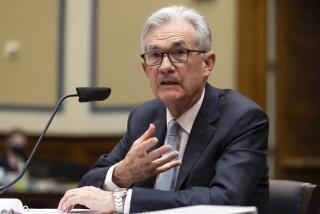Bush Must Act Swiftly to Make ’89 a Good Year
What’s ahead in 1989? Forecasts are a dime a dozen and of limited use, unfortunately. For example, 50 business economists in a survey by Blue Chip Economic Indicators vary from 2% to 3.9% in predictions of U.S. economic growth.
But that’s an enormous range--a 1.9-point spread represents $90 billion in the $4.7-trillion U.S. economy. And you don’t need a Ph.D. to know that can make a difference: If the economy produces an additional $90 billion in goods and services, there will be money around to solve problems such as the budget deficit; if it doesn’t, things will be tighter.
The point is, you may as well judge for yourself. Seriously. No one can really predict the future, so forecasters look at current events, recall past experience and draw conclusions. You can do the same--if you know what to watch for.
And in 1989 the smart money will be watching President George Bush. New presidents usually have to take care of unfinished business. Eisenhower ended the Korean War, Reagan curbed inflation. Now Bush, say the forecasters, must deal with the budget deficit--the $150-billion difference between what government receives in taxes and pays out on federal programs.
Bush is likely to act quickly, using prominent cuts in the defense budget as a means of persuading Congress to cut other programs. Social Security and Medicare, specialties of Bush’s chief economic adviser Michael J. Boskin, may come in for rejiggering.
But more important than how much the budget is cut will be Bush’s firmness in cutting it. If the new President shows he’s in command, international markets will buoy the value of the dollar. Nervousness about the world economy will change to confidence.
And to give the world economy room to grow, Bush will need to bring some movement to the Latin American debt problem. The Latin American region contains great opportunity, with more urban customers and manufacturing industry than all of Asia outside Japan.
So watch for a new debt agreement, with the U.S. government protecting American banks as they write down more of their loans. Shoring up banks, in fact, may well become 1989’s equivalent of last year’s savings and loan bailouts.
Spending Should Grow
On the plus side, renewed growth in Latin markets will boost U.S. exports and reinforce a strong trend in business spending. The Commerce Department forecasts a 6% rise in capital spending, but economist David Levine, of the Sanford C. Bernstein research firm, thinks spending by such industries as paper, chemicals, airlines, railroads and agriculture will rise by more than 10% to make up for skimpy investment in past years.
So watch for business spending to grow strongly, which means good news for jobs, and also for real estate in the Midwest.
Elsewhere, real estate may not be strong, especially in the Northeast where prices have been hurt by the lingering post-Crash drying up of the brokerage business.
Wall Street merger makers will be active, but emphasis may shift from bust-up deals, like RJR Nabisco, to mergers that form alliances between companies. Watch for the Bush Administration to back mergers aimed at strengthening U.S. efforts in global markets.
And watch for more foreign buying of U.S. companies--chances are Japanese investors will buy a Hollywood movie company in 1989.
What about the stock market? Predicting it is impossible, but interpreting it is not. The 1987 crash, for instance, told us that the world viewed America as a risky investment. And international investors have since been unenthusiastic about U.S. stocks and bonds.
So, if the market--as many predict--falls sharply late this year, it would foreshadow a recession in 1990. But it’s a better bet that, thanks to 1989’s opportunities for world economies, the market will be higher this time next year.
What could upset such a vision? All sorts of troubles, but one in particular: If the world perceives Bush and the United States to be drifting rather than leading, the effect on confidence would be terrible. However, chances are the new quarterback has some kind of game plan for the first quarter. So watch for a good new year.
More to Read
Inside the business of entertainment
The Wide Shot brings you news, analysis and insights on everything from streaming wars to production — and what it all means for the future.
You may occasionally receive promotional content from the Los Angeles Times.










